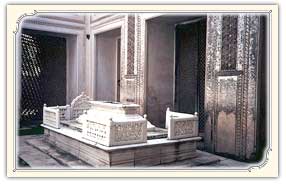 Some of the most influential families of the Hyderabad aristocracy were the families of the Paigah. The Paigah nobles were believed to be richer than the Indian Maharajah and earned the rights to solely manage their courts, palaces and armies that would often go up to thousands of soldiers. The English equivalent for the word Paigah actually means 'right hand man' or 'footstool'. The tombs are spread over 30-40 acres and are dedicated to the Paigahs, the consorts of the Paigahs and the daughters of Nizams. The Paigah tombs are very famous mausoleums that hold the caskets of the entire Paigah fraternity. The complex marble structures at the complex and the palatial entrances are a window into the wealthy, imperial past of the Paigahs. Apart from the intricate marble works, the tombs also illustrate the family tree of the royal families, along with chants and tributes etched on the epitaphs. Scroll down for more.
Some of the most influential families of the Hyderabad aristocracy were the families of the Paigah. The Paigah nobles were believed to be richer than the Indian Maharajah and earned the rights to solely manage their courts, palaces and armies that would often go up to thousands of soldiers. The English equivalent for the word Paigah actually means 'right hand man' or 'footstool'. The tombs are spread over 30-40 acres and are dedicated to the Paigahs, the consorts of the Paigahs and the daughters of Nizams. The Paigah tombs are very famous mausoleums that hold the caskets of the entire Paigah fraternity. The complex marble structures at the complex and the palatial entrances are a window into the wealthy, imperial past of the Paigahs. Apart from the intricate marble works, the tombs also illustrate the family tree of the royal families, along with chants and tributes etched on the epitaphs. Scroll down for more. Poetry In Marble
The Nizams And The Paigahs
Founded by Abdul Fateh Khan Tegh Jung, the Paigah nobility were conferred the task of defending and securing the princely state of Hyderabad. These orders were given to the Paigahs by the Nizams. An interesting fact to note is that the Paigahs were very close to the Nizams of Hyderabad. Their bonds strengthened, when a Paigah royal, Fakhrudin Khan, married the daughter of the second Nizam of Hyderabad, in 1797. Since then, the Paigahs were considered next only to the Nizams.
History
The tombs were constructed in 1787 by Nawab Taig Jung Bahadur and later refurbished by his son, Amir E Kabir. The tombs were built as final resting places for the several generations of the Paigah nobles such as Sir Khursheed Jah, Sir Vicar-ul-Umra, Sultan-ul-Mulk and Zaheer yar Jung to name a few.
Artistry And Architecture
The tombs are magnificent marble structures festooned with stucco work, Rajasthani and Mughal patterns. The tombs are unique for each royal, some perforated with family tree screens and the others decorated with Persian, geometrical designs, portraying the great craftsmanship of the time. At the entrance of the Paigah Tombs, the tomb of Teng Jung can be seen, exquisitely designed with lattice work and shadowed by a huge canopy. The white marble and the semi-circular arches stand out and are a dazzling sight for those who are visiting the tombs for the first time. 'Jali' works add to the splendor of these magnificent tombs, reflecting the aesthetic, artistic taste of the nobles.
How To Reach
By Road
The Paigah tombs are located 10 kms from the heart of the city. You could hire a local taxi or an auto-rickshaw or also board a bus from the nearest bus depot. If you are travelling by bus, you will have to disembark at the Mehadipatnam bus depot to get to the Paigah tombs. You could either walk or choose to take local transport.
The Paigah Tombs are unique mausoleums that feature some of the most intricate designs and are the final resting places of the Paigah nobles belonging to the 18th century. Built with lime, marble and mortar in the Indo-Saracenic style, these tombs are magnificent works of art. If you are visiting Hyderabad, make sure you spare a day to visit and revel in the beauty of these famous tombs.